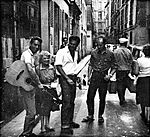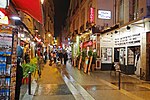Place Saint-Michel
1855 establishments in FranceBuildings and structures in the 5th arrondissement of ParisBuildings and structures in the 6th arrondissement of ParisFrance stubsLatin Quarter, Paris ... and 2 more
Odonyms referring to religionSquares in Paris

The Place Saint-Michel is a public square in the Latin Quarter, on the borderline between the fifth and sixth arrondissements of Paris, France. It lies on the left bank of the river Seine facing the Île de la Cité, to which it is linked by the Pont Saint-Michel.
Excerpt from the Wikipedia article Place Saint-Michel (License: CC BY-SA 3.0, Authors, Images).Place Saint-Michel
Place Saint-Michel, Paris 6th Arrondissement (Paris)
Geographical coordinates (GPS) Address Nearby Places Show on map
Geographical coordinates (GPS)
| Latitude | Longitude |
|---|---|
| N 48.853333333333 ° | E 2.3438888888889 ° |
Address
Services Tickets RATP (Saint-Michel)
Place Saint-Michel
75006 Paris, 6th Arrondissement (Paris)
Ile-de-France, France
Open on Google Maps









